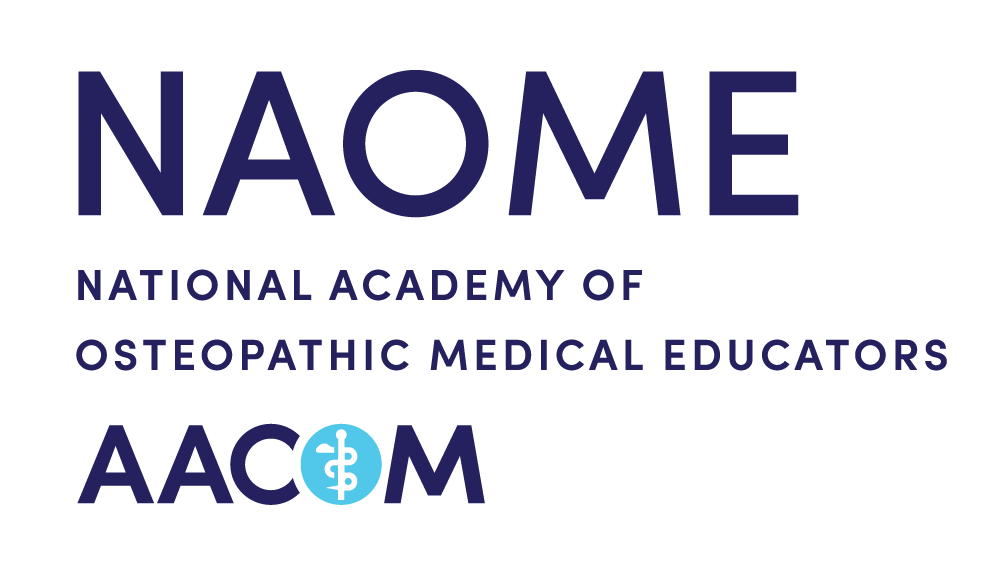Teaching/Evaluation
Summary
This award will be given to individuals with a record of quality, quantity, and breadth of teaching and/or evaluation of learners which matches or exceeds the evidence contained in the standard-setting portfolio examples at the bottom of this page.
Teaching and Evaluation: activities might include: preparing and giving lectures; teaching in the ambulatory setting; teaching rounds; facilitating small groups; working one-on-one with learners; making education-related presentations; assisting in learner evaluations (i.e. OCSE's). The learners may be students, faculty (faculty development), and other teaching/learning activities done as an osteopathic medical educator, e.g. community teaching.
Evidence of Quality: (e.g., success of teaching) include: a description of your goals, preparation to teach, and ongoing development; summarized student ratings; peer observation/review; course director ratings; letters of support; outcome indicators (student performance); and enrollment figures. This criterion will count 50 percent of the final judgment of the review panel.
Evidence of Quantity: (e.g., amount of teaching) include: number of hours teaching (duration and frequency of lectures); number of years teaching; number of learners and/or groups taught. This evidence should focus on activities as an educator within the past five years. This criterion will count 40 percent of the final judgment of the review panel.
Dimensions of Breadth: (e.g., diversity of teaching) might include: different levels or types of learners; different courses; different styles/formats of teaching or evaluation; old versus new curriculum; internal versus external teaching. This criterion will count 10 percent of the final judgment of the review panel.
Instructions for Submitting Portfolios
Before starting your portfolio:
- Review the NAOME Portfolio Preparation Criteria
- Check out the Portfolio Examples below
- Understand the Evaluation Rubric below
Portfolio Examples
The following examples set the standards of quantity, quality, and breadth for the category of Teaching and Evaluation. You must accumulate and document at least as much evidence of accomplishment as contained in one or more of these examples. While your exact combination of accomplishments related to quality, quantity, and breadth will be unique, you will be required at the start of your mini-portfolio to identify which standard-setting example(s) best match(es) the types of teaching and evaluation you have included.
The structured summaries in each of these examples have been prepared using a template which you should use in your portfolio. You can use the 'save as' feature to copy the template into a Word document for creation and uploading of your portfolio. ( Download portfolio template.) You can use the 'save as' feature to copy the template into a Word document for creation and uploading of your portfolio.
You should also use in your descriptions of quantity the types of information included in the standard-setting portfolio example(s) best matched to your accomplishments.
Portfolio Example 1
Faculty member or possessing a terminal degree in a basic science department who actively participates in both medical school and graduate school courses.
Portfolio Example 2
Physician in a clinical department who teaches both students and residents in lecture, small groups, and at the bedside.
Portfolio Example 3
Experienced faculty member in a basic science department who teaches almost entirely in the graduate school.
Portfolio Example 4
Physician in a clinical department who primarily works with students and possibly residents in a clinical setting.
Portfolio Example 5
Physician in a clinical department who primarily works with residents in a clinical setting.
Evaluation Rubric for Teaching and Evaluation
Applicant Name: __________________________________________________________________
Reviewer Name: __________________________________________________________________
Type of Review: ___Primary, ___Secondary, or ___General
Assign points based on comparison to prototypes—assume prototypes would earn 85-95 points.
Use sample questions after each criterion as a guide for interpretation.
| Maximum Points Possible | Reviewer Assigned Points | |
1. The applicant’s personal standards of osteopathic focus or impact within/upon osteopathic medical education. (The standards of osteopathic focus or impact within/upon osteopathic medical education will be awarded based on the applicant's personal statement and mini-portfolio.)
| 10 points | ||
Application Quality – evidence of quality | 2. Clear, realistic, and important goals (e.g., Are personal goals specific and appropriate? Do goals reflect the needs of learners? Is the development of enduring materials guided by a cohesive set of professional goals?) | 5 points | |
3. Adequate personal preparation and ongoing self-reflection/improvement (e.g., Does faculty have skills matching his/her role in preparing enduring educational materials? In what ways has faculty prepared to develop educational materials? Does teacher, leader, or developer solicit and use feedback from learners and peers?) | 10 points | ||
4. Adequate methods/Quality of presentation of results (e.g., Are systematic instructional design methods used to prepare enduring educational materials? Do learners use the enduring educational materials as intended? Are desired learning outcomes achieved? Is mini- portfolio clear? Does designer effectively share lessons learned with peers? Are "lessons" learned about teaching, educational leadership or the preparation of enduring educational materials shared with peers at local, regional, or national levels?)
| 30 points | ||
5. Quantity (e.g., Numbers of: Textbook or textbook chapter; Manuals, Guidelines, Curriculum Guides; Patient education materials; Case vignettes produced in print, video or electronic formats; Items used in learner evaluations; Computer-assisted instruction distributed in CD or WWW formats; Audio-visual materials; Simulations created with computers and/or physical models; Tools to create enduring materials (e.g., template for creating cases); CME program materials; Resources used in conducting workshops or other teaching sessions; Resources developed for community outreach, K-12, or collegiate education or patient education; Review articles and extended abstracts with clear educational value, etc.) | 35 points | ||
6. Breadth (e.g., number of different learner populations, number of different types of enduring materials, etc.)
| 10 points | ||
Total (80 points minimum needed to receive award) | 100 points | 0 | |

